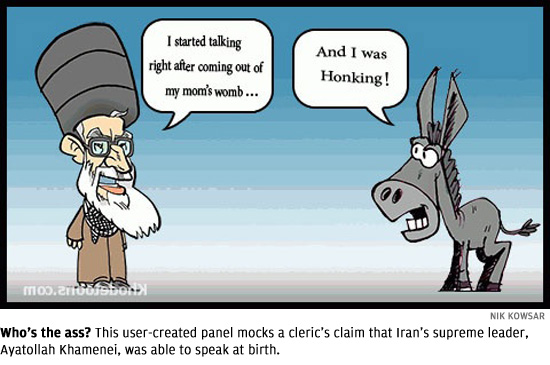
For years, Nik Kowsar managed to stay out of jail while building a reputation as Iran’s most infamous political cartoonist. Then, in early 2000, his luck ran out. He was arrested for publishing a cartoon that depicted a powerful ayatollah as a crocodile strangling a journalist with his tail. His arrest sparked protests by religious conservatives who called for his execution. When international pressure on the eve of parliamentary elections in Iran won his release after six days, Kowsar feared for his life. In 2003, he fled to Canada, where he joined a rich tradition of political exiles who continue to hammer at repression in their countries from the relative safety of the West. In 2009, Kowsar, who now lives in Washington, DC, started Khodnevis, the first Persian-language citizen-journalism platform. And last year, he launched Khodetoons, a do-it-yourself political cartooning site. CJR’s Brent Cunningham spoke to him in July about the cartoon site.
Why did you do this?
I wanted to give a voice to people who were interested in cartoons but didn’t have the ability to draw. Because many people would love to say something, and if they draw a bad cartoon, then nobody pays attention.
How did you do it?
The difficult part was turning Persian fonts into JPEG or PNG. We succeeded eventually, but still have some glitches. So we are keeping the site in beta phase for now. We didn’t want it to be a Flash site, because we want this to be easy for people inside Iran who must use proxies to get through firewalls; when you use a proxy, you cannot open a lot of Flash files.
Do you draw all the characters?
Yes, and I’ve drawn a bunch of others that we haven’t posted yet. We’ll also add more backgrounds. We have about nine backgrounds now, and we’ll probably have around 50 when we move out of beta. We didn’t want to do what they do at The New Yorker, where the cartoonist draws the cartoon and the reader just fills in the caption. We thought if we give different backgrounds, characters, and situations to the users, they could come up with better words than we could.
How many cartoons have been done so far?
A couple hundred, at least. One of the cartoons posted last year got something like 160,000 visits, but this platform was not envisioned primarily to display cartoons. We want to make them shareable via Facebook, Twitter, and other social networks to enable the cartoons go viral.
One of your Six Commandments for using the site is not to insult someone. Isn’t that the point?
In Iranian culture, there is a difference between satire and insulting with comedy. We did it that way so that people would feel more comfortable. I’m sure you’ve never seen, in a newspaper or website, a cartoon of the British prime minister having sex with the Queen. It’s bad taste. They don’t publish it. Instead, you have wordplay to suggest certain things that are not seen. But if you are talking about kicking the politicians in their sensitive parts, we definitely love to do that.
Will you expand beyond an Iranian audience?
We want to invite international cartoonists from different countries to add their own characters and pass this on to their audiences and ask them to participate. I was in Tunisia in early May for a workshop with the cartoonists from Tunisia, Egypt, and Jordan. And we talked about, why not give a voice to the Egyptian people? To the Tunisian people? To the people of the Middle East?
How do you moderate it?
This is something we are thinking about right now. We have to go through the experiences of other social networks—how do they monitor without being censor machines? Is it based on reports by other users, or by randomly checking the cartoons created by the members? For now, we don’t have an answer. So for the cartoons thus far, they are all Iranian cartoons. I am an Iranian cartoonist and my colleague is an Iranian editor, so we go through them and if it has, let’s say, bad words, we remove them. Or if we have the email of the person who did the cartoon, we write them and ask them to do something else.
Has the Iranian government tried to block this site?
Yes. I got a message last year saying the person first didn’t need a proxy to access the site, and now they did. We have set it up so even if the Iranian government hacks the back end of the site, they can’t tell who has drawn the cartoons. Probably the most important thing for us is the security of the users. The Iranians are very good hackers
Brent Cunningham is CJR’s managing editor.
